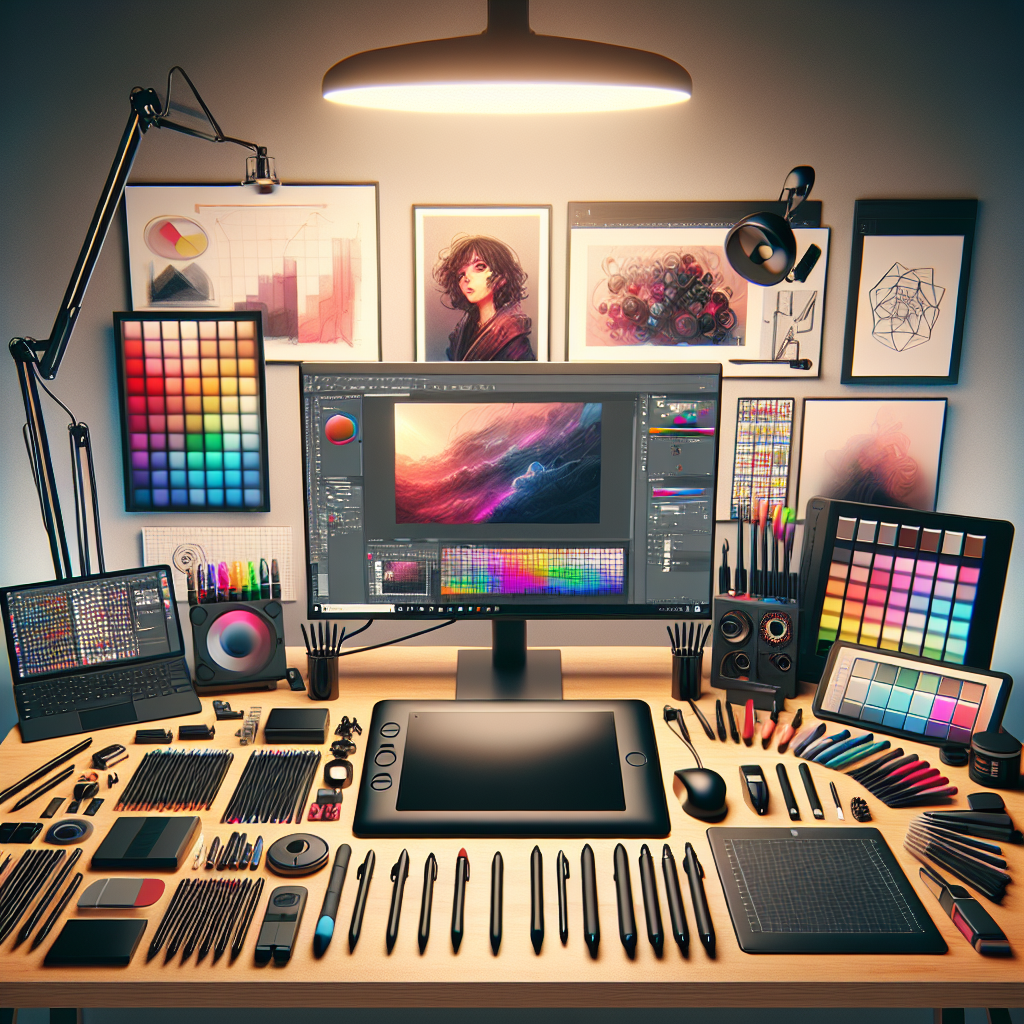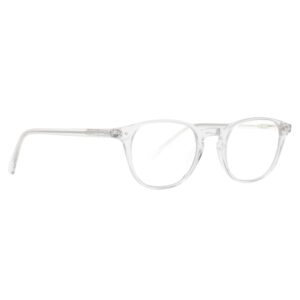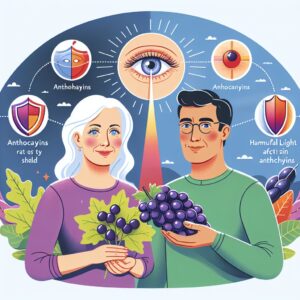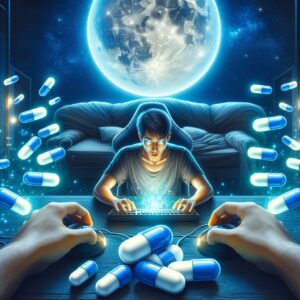
Key Takeaways
- Understand why blue light protection is crucial, especially for digital artists who spend long hours in front of screens.
- Discover the top supplements that can help shield your eyes from the harmful effects of blue light.
- Learn how to create a workspace that minimizes blue light exposure without compromising your artistic workflow.
- Find out how integrating the right supplements into your daily routine can boost your overall eye health and creative output.
- Get insights from real digital artists who have benefited from managing blue light exposure effectively.
Why Blue Light Protection Matters for Digital Artists
As a digital artist, you spend countless hours in front of screens, crafting visuals that capture the imagination. But there’s an invisible risk that comes with this digital canvas—blue light. This high-energy light is emitted from screens and can lead to eye strain, fatigue, and even disrupt your sleep patterns. But fear not, because you have the power to protect your eyes and maintain your artistic edge. How? By incorporating blue light eye supplements into your daily routine.
Top Supplements to Combat Blue Light Exposure

When it comes to defending your eyes against blue light, not all supplements are created equal. You’ll want to look for products that contain ingredients like lutein, zeaxanthin, and omega-3 fatty acids. These nutrients are the superheroes of eye health, working tirelessly to filter out blue light and prevent damage to your retina.
Let’s break it down:
- Lutein and Zeaxanthin: These carotenoids are found in the eye’s macula and act as a natural sunblock, absorbing excess light.
- Omega-3 Fatty Acids: Essential for overall eye health, they play a crucial role in cell membrane integrity and retinal function.
Remember, it’s not just about popping pills. Your diet matters too. Foods rich in these nutrients, like leafy greens and fish, should be staples on your plate. But, let’s be real, it’s tough to get enough from diet alone, which is where supplements come in handy.
Seeing the Light: Understanding Blue Light Exposure

“Gray laptop computer beside tablet …” from www.pickpik.com and used with no modifications.
The first step to battling blue light is understanding it. Blue light is a type of visible light with a short wavelength, which means it’s high-energy. It’s everywhere—not just in your studio. The sun emits it too. But it’s the artificial sources, like your tablet, smartphone, and monitor, that have us concerned.
The Science of Blue Light: How It Affects Artists
Here’s the science bit: prolonged exposure to blue light can lead to digital eye strain, causing symptoms like dry eyes, headaches, and blurred vision. Over time, it can even contribute to age-related macular degeneration. As an artist, your eyes are your most valuable asset, so protecting them isn’t just about comfort—it’s about safeguarding your career.
But it’s not all doom and gloom. Blue light has its perks too—it boosts alertness and helps regulate your circadian rhythm. The trick is to balance your exposure, especially during your prime creative hours.
Exposure and Timing: When Blue Light Is Beneficial
Blue light isn’t the enemy; it’s all about timing. Exposure during the day is beneficial. It keeps you alert and on top of your game. But as the sun sets, it’s a different story. That’s when you should start dialing down the blue light to prep your body for a restful sleep, which is just as important as your work.
Most importantly, remember that your health comes first. If your eyes are telling you to take a break, listen. A five-minute break every hour can work wonders. And during those breaks, why not give your eyes a workout? Look at something 20 feet away for 20 seconds. It’s a small step that goes a long way in keeping your eyes sharp.

“Free Images : artist, hand, visual arts …” from pxhere.com and used with no modifications.
As digital artists spend long hours in front of computer screens, the risk of eye strain and exposure to blue light increases. To mitigate these effects, it’s important to consider supplements that specifically address the visual challenges associated with prolonged screen time.
Key Ingredients to Look For in Supplements

When selecting blue light supplements, it’s essential to know which ingredients will give you the best defense. Look for supplements that contain a mix of lutein, zeaxanthin, and omega-3 fatty acids. These key ingredients have been shown to support eye health and may help filter out harmful blue light. For instance, lutein and zeaxanthin are antioxidants that are naturally present in the macula of the eye, providing a layer of protection against light-induced damage. Omega-3s, commonly found in fish oil, are vital for maintaining cell structure in the eyes and supporting overall vision health.
Comparing Popular Blue Light Supplement Brands
With so many blue light supplements on the market, it can be overwhelming to choose the right one.
When you’re comparing brands, consider not just the content of the key ingredients but also the presence of additional beneficial elements, like vitamins and minerals that support eye health. Always check for quality assurance and opt for brands that have undergone third-party testing.
Creating in Comfort: Tips to Reduce Blue Light Impact
While supplements are an important part of protecting your eyes from blue light, there are other steps you can take to reduce its impact. For starters, adjust the lighting in your workspace. Aim for indirect, soft lighting that reduces glare and doesn’t shine directly into your eyes or onto your screen. Additionally, take regular breaks using the 20-20-20 rule: every 20 minutes, look at something 20 feet away for at least 20 seconds.
Another tip is to use blue light filtering software on your devices. Most smartphones and computers now come with built-in settings that reduce blue light emissions, especially in the evening hours. Make it a habit to enable these settings to help minimize eye strain.
Workspace Adjustments for Minimal Blue Light Exposure
“Creating art is about finding your flow, but don’t let blue light throw you off. Make your workspace work for you. Position your screen so there’s no glare, and use a monitor arm for the perfect angle. Your eyes will thank you.”
It’s also worth investing in a high-quality monitor that has a blue light filter built-in. If that’s not an option, consider applying a blue light filter screen protector to your current monitor. The goal is to create a workspace that allows you to work for extended periods without compromising your eye health.
Lastly, the color temperature of your screen can make a big difference. Cooler, bluer light is more likely to cause strain, so set your display to a warmer, more yellow hue. This small tweak can have a significant impact on reducing eye fatigue.
Combining Diet and Supplements for Optimal Eye Health

“Whole smoked mackerel on a dark …” from www.flickr.com and used with no modifications.
Remember, supplements are just one piece of the puzzle. A balanced diet rich in eye-friendly nutrients can complement the effects of your blue light supplements. Here are some foods to include in your diet:
- Leafy greens like spinach and kale are high in lutein and zeaxanthin.
- Fatty fish such as salmon and mackerel are excellent sources of omega-3 fatty acids.
- Citrus fruits and berries are packed with vitamin C, an antioxidant that can help protect the eyes.
- Nuts and seeds contain vitamin E, which can slow down age-related eye changes.
Combining a well-rounded diet with high-quality supplements creates a robust defense against blue light and supports overall eye health, allowing you to focus on your art without worry.
Mastering Your Craft Without the Glares
As an artist, you’re constantly looking for ways to improve your craft. Integrating blue light supplements into your daily routine can help maintain your eye health, which is vital for your artistic work. Start by setting a reminder to take your supplements at the same time each day, making it a habit that’s as natural as picking up your stylus or brush.
Integrating Supplements into Your Daily Routine

Consistency is key when it comes to supplements. Whether it’s with breakfast or as part of your night-time routine, find a time that works for you and stick to it. Pairing your supplement intake with a regular activity, like your morning coffee or evening wind-down, can help cement this new habit.
Non-Supplemental Aid: Tools and Tech for Blue Light Reduction
Besides supplements, there are tools and technology designed to reduce blue light exposure. Here are a few to consider:
- Blue light blocking glasses: Wear them while working to filter out blue light directly from the source.
- Screen protectors: These can be applied directly to your devices and help minimize blue light exposure.
- Adjustable desk lamps: Look for lamps with blue light filtering capabilities or use bulbs that mimic natural sunlight.
By combining these tools with your supplements, you’re giving your eyes the best possible protection, allowing you to create without the strain and discomfort that comes from excessive blue light exposure.
Real Stories, Real Success: Artists and Blue Light Management
In the world of digital art, real-life success stories can be the most convincing evidence that managing blue light exposure is crucial. Let’s dive into the experiences of artists who have taken steps to protect their eyes and how it has affected their work and well-being.
Interviews with Digital Artists Who Use Supplements
I spoke with several digital artists who have incorporated blue light supplements into their daily routines. Ernestina, a graphic designer, told me, “Ever since I started taking lutein and zeaxanthin supplements, I’ve noticed less eye strain. I can focus on my work for longer periods without discomfort.” Another artist, Alexis, mentioned, “Adding omega-3 supplements to my diet has made a noticeable difference in my visual clarity and reduced the dryness in my eyes.”
The Impact of Blue Light Supplements on Artistic Productivity
The consensus among the artists I interviewed was clear: managing blue light exposure isn’t just about eye health; it’s about maintaining productivity. When your eyes are less fatigued, you’re able to work more efficiently and for longer stretches. This means more time to refine your art, meet deadlines, and let your creativity flow without the nagging distraction of eye discomfort.
FAQs
How Long Does It Take to Notice the Effects of Blue Light Supplements?
Most artists I’ve spoken with began to notice improvements in eye comfort and reduced strain within a few weeks of starting blue light supplements. However, it’s important to remember that individual experiences may vary, and consistent use over time is key to seeing the benefits.
Can Blue Light Supplements Improve My Sleep as a Digital Artist?

“A Woman Sleeping with a Sleep Mask …” from www.pexels.com and used with no modifications.
Yes, they can. Blue light has been shown to disrupt sleep patterns, and by limiting your exposure, especially in the evening, you can improve the quality of your sleep. Many artists report better sleep after taking steps to manage blue light, which in turn can enhance focus and creativity during work hours.
Are There Side Effects Associated with Blue Light Supplements?
Blue light supplements are generally considered safe for most people. However, it’s always wise to consult with a healthcare professional before starting any new supplement, especially if you have pre-existing health conditions or are taking other medications.
Do Blue Light Filters on Electronic Devices Replace the Need for Supplements?
Blue light filters on devices are a helpful tool, but they may not block all blue light. Supplements serve as an additional layer of protection and can help fill in the gaps, especially for those times when you can’t control the light emitted from your screens.
Is There a Difference in Blue Light Exposure from Various Digital Screens?
Yes, there can be. The intensity and amount of blue light emitted can vary depending on the type of screen and its settings. For instance, newer models often have better built-in blue light reduction features. However, no matter the screen, taking measures to protect your eyes is still important.
As digital artists, our eyes are the windows to our creative souls. By understanding and managing blue light exposure, we can preserve our vision and continue to create the stunning visuals that define our work. Remember, it’s not just about the immediate comfort; it’s about ensuring a long and vibrant career doing what we love. So, let’s keep those eyes healthy, our screens adjusted, and our supplements close at hand.


